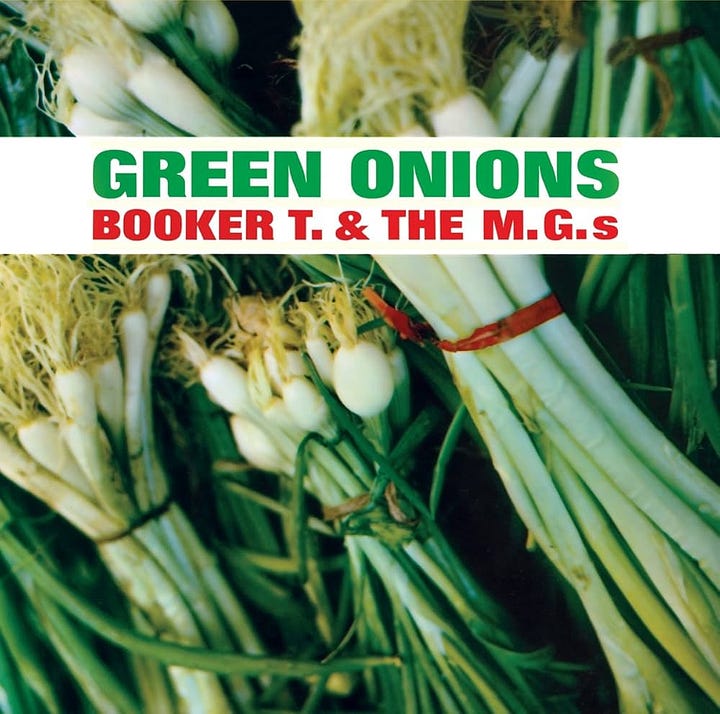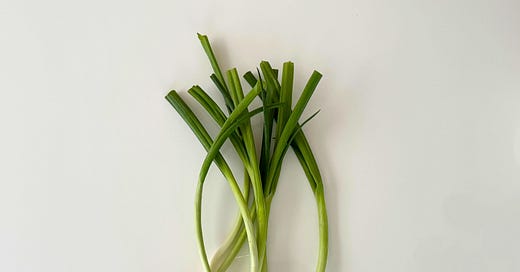I lament the sight of a long-limbed green onion smooshed into grocery store plastic.
Tearing through synthetic polymer is supremely unappealing, but the liberation from their garb I imagine — I hope — feels at least a trace restorative. Their green gradient I always admire, like tender fistfuls of cricket-green glow sticks that haven’t yet been fully cracked. So while their immediate vibrance may have diminished on the journey to me, my instinct as a fellow earthly body is to prolong their vitality as much as I can.
I cut their rubber restraints and snuggle them in a small mason jar of water. Given I struggle mightily to understand the temperament of my peace lily (it’s been three years, sigh), I was excited by a plant that felt easy to take care of and would, I soon learned, reward my effort liberally. Each morning I awoke to the small green stalks a centimeter longer. I let them be until they grew lanky and deeply pigmented. They sat in the windowsill and stretch in all directions it seemed, though always toward the sky. Their expansive growth was oblivious in its drama, akin to tulips bending and fanning at the end of their life.
While a paramount ingredient in many East Asian cuisines, green onions are now grown and embraced around the world. They are the youngest in the allium family, as they are often harvested early as “immature onions.” This youthfulness lends to their flavor, often described as milder or softer than their fully-matured counterparts — onions, spring onions, shallots, chives, leeks, and garlic.
However, “mild” and “soft” aren’t the only words to describe these alliums when juxtaposed with their siblings. On their 1962 all-instrumental debut album, R&B band Booker T. & the MG’s famously named a track “Green Onions.” A Financial Times article notes when the band was originally trying to come up with a name for the song, they observed it was “so funky that it stinks.” Drummer Al Jackson replied, “It stinks like green onions.”
Thanks to its funk, “Green Onions” hit number three on the Billboard Hot 100 that year and is described as, “one of the most popular instrumental rock and soul songs ever,” by music journalist Richie Unterberger. The album cover even featured a glamour shot of these superstar alliums.


I employ both soft and funky parts of green onions equally — because they are each exceptional cooking companions. When I think soft, I think of the green, which are divine scissored as garnish on cold peanut noodles, scrambled eggs, braised tofu, or anything hearty and incomplete without an herby tinge.
When I think funky, I think of the bare white bottoms. Their sharp aroma is most similar to those of larger onions. With heat, however, this sharpness relaxes and their fragrance dims as if on a dial. I appreciate such transformation of staunchness into a parallel softness — chopped and tossed into a pan where kimchi fried eggs cook or in a bowl where I douse them with sizzling oil to draw out fragrance. I observe the remnants of those severe edges dissolve into tender drifts coiling in my nose before any food hits my tongue.
Perhaps the flavor of green onions hits so precisely because it has such a “funky” smell. In her book, Gulp: Adventures on the Alimentary Canal, author Mary Roach explains that, “Eighty to ninety percent of the sensory experience of eating is olfaction.” Even if I’m not consciously consuming green onions, their fragrance is consuming me. When shot with heat, the alliums release an earthy whiff my senses perk up at. Just like Booker T. and the M.G.’s. recognized, green onions have a soulful something that cannot be ignored.
Indeed, every day I dote on my green onions. I am uncritical of their growth. I was reluctant to trim them because I didn’t want to interrupt their theater. Every day they were a little taller, a little zanier. Only when stalks began splaying across my countertop did I begin to barber them. They made me think of myself, watering and sprouting, watering and sprouting, watering and sprouting, until all that I put my energy into is ready to be separated from me. It goes off, an extension of my soul to wander into parts yet unknown, perhaps to places that help others grow. I am reminded of this every day when I look at those darling onions.
A parent of any kind (plant or otherwise) will likely relate to how fulfilling it is to watch growth develop by their own hand. Growth that is unabashed in both its sharpness and softness, because, just like a green onion, it so often is. Growth that when shed of restraints moves in the direction that compels and even surprises by proclivities that emerge. As the youngest sibling, green onions exemplify the harmony in duality, their sharpness as strong as their softness, their growth as comical as it is crucial. Above all, what I witness is growth that’s worth grooving to — as those green onions can’t help but stretch clownishly toward the stars, funk and all.
Thank you for being here. If you enjoyed this essay, please consider giving it a ♥️ or share with someone you love. Your support helps sustain my work.






“Only when stalks began splaying across my countertop did I begin to barber them.”
will always think of a doting haircut every time I trim my scallions
"They made me think of myself, watering and sprouting, watering and sprouting, watering and sprouting, until all that I put my energy into is ready to be separated from me. It goes off, an extension of my soul to wander into parts yet unknown, perhaps to places that help others grow." I have never felt in more kinship with green onions than this paragraph. Beautiful writing as always my friend!